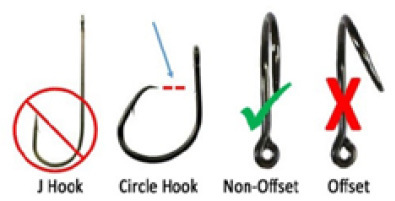Frequently Asked Questions
Circle hooks are required when fishing recreationally for striped bass with bait.
How to Properly Measure a Fish
Total Length Measurement
The total length is the maximum length of the fish, from the tip of the snout to the tip of the tail. The best way to obtain this length is to push the fish’s snout up against a vertical surface with the mouth closed and the fish laying along or on top of a tape measure. Measure to the tip of the tail or pinch the tail fin closed to determine the total length. Do NOT use a flexible tape measure along the curve of the fish, as this is not an accurate total length measurement. When measuring the total length of black sea bass, do NOT include the tendril on the caudal fin.


Q: - What is a circle hook and how does it differ from other hooks?
A: - A circle hook is a non-offset hook where the point is pointed perpendicularly back towards the shank. Some hooks like J hooks have points which don’t curve back toward the shank. Other hooks are offset with a bend that position the point out of line with the shank.
Q: - How do circle hooks help Striped Bass?
A: - Circle hooks are designed to reduce release mortality by hooking a fish in the corner of the mouth and reducing the incidence of deep (“gut”) hooking or ingestion of the hook.
Q: - How do I fish with a circle hook?
A: - Simply allow the line to tighten on its own when the fish runs and bring the fish in. There is no need to set the hook due to the circle hook design, the hook should catch in the corner of the fish’s mouth.
Q: - Do artificial lures need a circle hook?
A: - No, the circle hook requirement does not apply to any artificial lure with or without bait attached. This includes tube and worm rigs, pork rind, and naked bucktails.
Q: - Do artificial baits require a circle hook?
A: - Circle hooks are only required when fishing recreationally for striped bass with bait which is defined as any marine or aquatic organism live or dead, whole or parts thereof.
Q: - Do I need a circle hook if I am not targeting striped bass but using bait?
A: - No, A circle hook is only required when fishing recreationally for striped bass with bait, which is defined as any marine or aquatic organism live or dead, whole or parts thereof. The circle hook requirement does not apply to any artificial lure with bait attached. Striped bass caught on any unapproved method of take must be returned to the water immediately without unnecessary injury.
Q: - If you catch a striped bass on a j-hook while fishing for another species do you have to release it?
A: - Yes, striped bass caught on any unapproved method of take must be returned to the water immediately without unnecessary injury.

